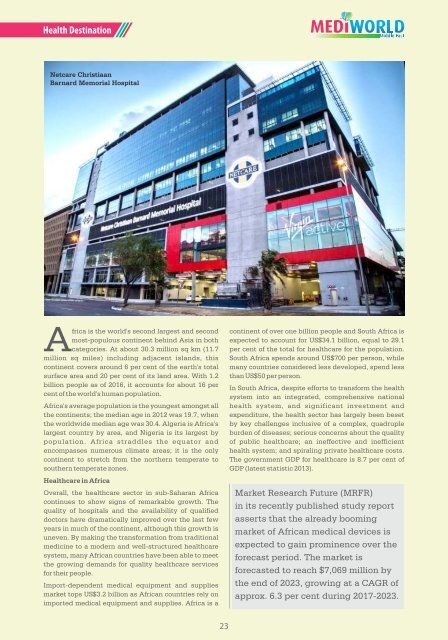Mediworld September-October 2018 LR
Create successful ePaper yourself
Turn your PDF publications into a flip-book with our unique Google optimized e-Paper software.
Health Destination<br />
Netcare Christiaan<br />
Barnard Memorial Hospital<br />
frica is the world's second largest and second<br />
Amost-populous continent behind Asia in both<br />
categories. At about 30.3 million sq km (11.7<br />
million sq miles) including adjacent islands, this<br />
continent covers around 6 per cent of the earth's total<br />
surface area and 20 per cent of its land area. With 1.2<br />
billion people as of 2016, it accounts for about 16 per<br />
cent of the world's human population.<br />
Africa's average population is the youngest amongst all<br />
the continents; the median age in 2012 was 19.7, when<br />
the worldwide median age was 30.4. Algeria is Africa's<br />
largest country by area, and Nigeria is its largest by<br />
population. Africa straddles the equator and<br />
encompasses numerous climate areas; it is the only<br />
continent to stretch from the northern temperate to<br />
southern temperate zones.<br />
Healthcare in Africa<br />
Overall, the healthcare sector in sub-Saharan Africa<br />
continues to show signs of remarkable growth. The<br />
quality of hospitals and the availability of qualified<br />
doctors have dramatically improved over the last few<br />
years in much of the continent, although this growth is<br />
uneven. By making the transformation from traditional<br />
medicine to a modern and well-structured healthcare<br />
system, many African countries have been able to meet<br />
the growing demands for quality healthcare services<br />
for their people.<br />
Import-dependent medical equipment and supplies<br />
market tops US$3.2 billion as African countries rely on<br />
imported medical equipment and supplies. Africa is a<br />
continent of over one billion people and South Africa is<br />
expected to account for US$34.1 billion, equal to 29.1<br />
per cent of the total for healthcare for the population.<br />
South Africa spends around US$700 per person, while<br />
many countries considered less developed, spend less<br />
than US$50 per person.<br />
In South Africa, despite efforts to transform the health<br />
system into an integrated, comprehensive national<br />
health system, and significant investment and<br />
expenditure, the health sector has largely been beset<br />
by key challenges inclusive of a complex, quadruple<br />
burden of diseases; serious concerns about the quality<br />
of public healthcare; an ineffective and inefficient<br />
health system; and spiraling private healthcare costs.<br />
The government GDP for healthcare is 8.7 per cent of<br />
GDP (latest statistic 2013).<br />
Market Research Future (MRFR)<br />
in its recently published study report<br />
asserts that the already booming<br />
market of African medical devices is<br />
expected to gain prominence over the<br />
forecast period. The market is<br />
forecasted to reach $7,069 million by<br />
the end of 2023, growing at a CAGR of<br />
approx. 6.3 per cent during 2017-2023.<br />
23

















